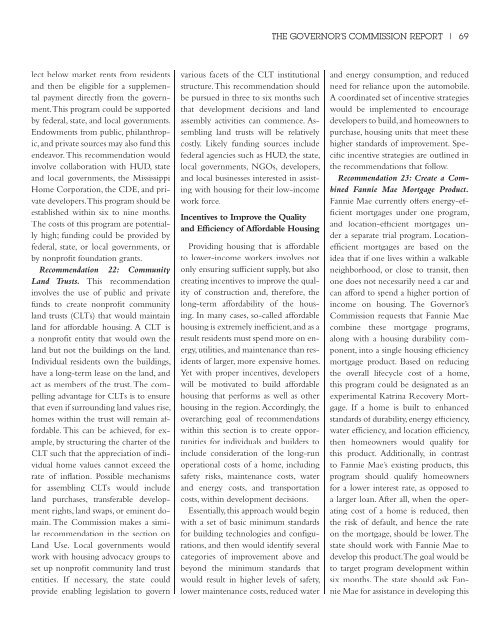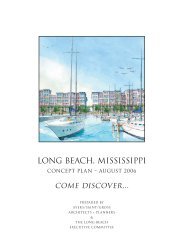Reports - Mississippi Renewal
Reports - Mississippi Renewal
Reports - Mississippi Renewal
- No tags were found...
Create successful ePaper yourself
Turn your PDF publications into a flip-book with our unique Google optimized e-Paper software.
THE GOVERNOR’S COMMISSION REPORT | 69lect below market rents from residentsand then be eligible for a supplementalpayment directly from the government.This program could be supportedby federal, state, and local governments.Endowments from public, philanthropic,and private sources may also fund thisendeavor. This recommendation wouldinvolve collaboration with HUD, stateand local governments, the <strong>Mississippi</strong>Home Corporation, the CDE, and privatedevelopers. This program should beestablished within six to nine months.The costs of this program are potentiallyhigh; funding could be provided byfederal, state, or local governments, orby nonprofit foundation grants.Recommendation 22: CommunityLand Trusts. This recommendationinvolves the use of public and privatefunds to create nonprofit communityland trusts (CLTs) that would maintainland for affordable housing. A CLT isa nonprofit entity that would own theland but not the buildings on the land.Individual residents own the buildings,have a long-term lease on the land, andact as members of the trust. The compellingadvantage for CLTs is to ensurethat even if surrounding land values rise,homes within the trust will remain affordable.This can be achieved, for example,by structuring the charter of theCLT such that the appreciation of individualhome values cannot exceed therate of inflation. Possible mechanismsfor assembling CLTs would includeland purchases, transferable developmentrights, land swaps, or eminent domain.The Commission makes a similarrecommendation in the section onLand Use. Local governments wouldwork with housing advocacy groups toset up nonprofit community land trustentities. If necessary, the state couldprovide enabling legislation to governvarious facets of the CLT institutionalstructure. This recommendation shouldbe pursued in three to six months suchthat development decisions and landassembly activities can commence. Assemblingland trusts will be relativelycostly. Likely funding sources includefederal agencies such as HUD, the state,local governments, NGOs, developers,and local businesses interested in assistingwith housing for their low-incomework force.Incentives to Improve the Qualityand Efficiency of Affordable HousingProviding housing that is affordableto lower-income workers involves notonly ensuring sufficient supply, but alsocreating incentives to improve the qualityof construction and, therefore, thelong-term affordability of the housing.In many cases, so-called affordablehousing is extremely inefficient, and as aresult residents must spend more on energy,utilities, and maintenance than residentsof larger, more expensive homes.Yet with proper incentives, developerswill be motivated to build affordablehousing that performs as well as otherhousing in the region. Accordingly, theoverarching goal of recommendationswithin this section is to create opportunitiesfor individuals and builders toinclude consideration of the long-runoperational costs of a home, includingsafety risks, maintenance costs, waterand energy costs, and transportationcosts, within development decisions.Essentially, this approach would beginwith a set of basic minimum standardsfor building technologies and configurations,and then would identify severalcategories of improvement above andbeyond the minimum standards thatwould result in higher levels of safety,lower maintenance costs, reduced waterand energy consumption, and reducedneed for reliance upon the automobile.A coordinated set of incentive strategieswould be implemented to encouragedevelopers to build, and homeowners topurchase, housing units that meet thesehigher standards of improvement. Specificincentive strategies are outlined inthe recommendations that follow.Recommendation 23: Create a CombinedFannie Mae Mortgage Product.Fannie Mae currently offers energy-efficientmortgages under one program,and location-efficient mortgages undera separate trial program. Locationefficientmortgages are based on theidea that if one lives within a walkableneighborhood, or close to transit, thenone does not necessarily need a car andcan afford to spend a higher portion ofincome on housing. The Governor’sCommission requests that Fannie Maecombine these mortgage programs,along with a housing durability component,into a single housing efficiencymortgage product. Based on reducingthe overall lifecycle cost of a home,this program could be designated as anexperimental Katrina Recovery Mortgage.If a home is built to enhancedstandards of durability, energy efficiency,water efficiency, and location efficiency,then homeowners would qualify forthis product. Additionally, in contrastto Fannie Mae’s existing products, thisprogram should qualify homeownersfor a lower interest rate, as opposed toa larger loan. After all, when the operatingcost of a home is reduced, thenthe risk of default, and hence the rateon the mortgage, should be lower. Thestate should work with Fannie Mae todevelop this product. The goal would beto target program development withinsix months. The state should ask FannieMae for assistance in developing this




